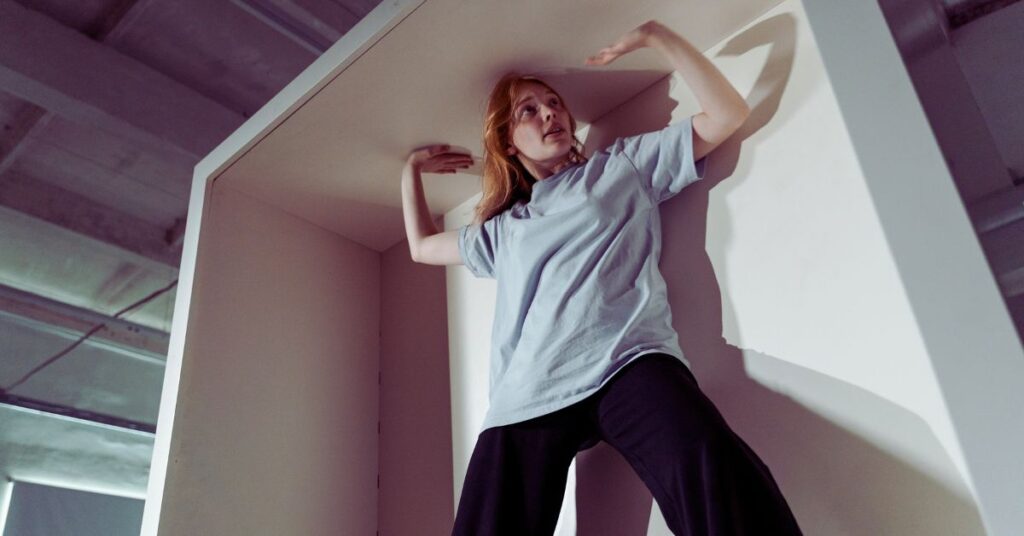Agoraphobia and claustrophobia are both anxiety disorders. They impact people’s daily lives.
Understanding their differences is key. Agoraphobia is the fear of open or crowded spaces. People with agoraphobia often avoid places where they feel trapped or helpless. Claustrophobia, on the other hand, is the fear of small, enclosed spaces. This could be elevators, small rooms, or even tight clothing.
Comparisons like these help us understand the unique challenges each condition presents. Knowing the differences can lead to better support and treatment. Let’s dive deeper into what sets these phobias apart and how they affect those who experience them.
Topic of Contents
ToggleSymptoms
Understanding the symptoms of agoraphobia and claustrophobia is crucial. These symptoms help in identifying and managing these conditions. Both phobias manifest differently. Let’s explore their symptoms in detail.
Agoraphobia Symptoms
Agoraphobia involves fear of open or crowded spaces. People may avoid leaving home. They fear public places where escape seems difficult. Panic attacks are common. They may feel trapped in large crowds. Some experience rapid heartbeat and sweating. Dizziness and shortness of breath can occur. Chest pain and trembling are also symptoms.
Claustrophobia Symptoms
Claustrophobia is the fear of confined spaces. Elevators and small rooms trigger this fear. People may feel suffocated. They often try to escape confined areas. Rapid breathing and increased heartbeat are common. Sweating and shaking can occur. Some experience nausea and dizziness. A strong desire to flee the space is typical.
Causes
Understanding the causes of agoraphobia and claustrophobia is crucial. These conditions, while different, both impact people’s daily lives. Delving into their origins can provide insights into managing and treating them.
Causes Of Agoraphobia
Agoraphobia often stems from past traumatic events. Experiencing panic attacks in public spaces can lead to fear of those places. Genetics also play a role. If a family member has agoraphobia, the likelihood increases. Stress and significant life changes can trigger symptoms. These factors combine to make public spaces feel unsafe.
Causes Of Claustrophobia
Claustrophobia typically starts in childhood. A frightening event in a small space can be a trigger. Genetics can influence this phobia too. If relatives have claustrophobia, the risk may be higher. Brain chemistry also plays a part. An imbalance in neurotransmitters can affect fear responses.
Triggers
Understanding the triggers of agoraphobia and claustrophobia is crucial for managing these conditions. Each phobia has specific situations or environments that can cause intense fear and anxiety.
Common Triggers For Agoraphobia
People with agoraphobia often fear places or situations where escape might be difficult. This fear can be triggered by:
- Crowded places like shopping malls or concerts
- Open spaces such as fields or large parks
- Public transportation including buses, trains, and airplanes
- Being alone outside their home
- Standing in lines or being in a confined space with many people
These triggers can cause panic attacks or intense anxiety, making it hard for the person to function normally.
Common Triggers For Claustrophobia
Claustrophobia involves a fear of enclosed spaces. The most common triggers include:
- Elevators and small rooms
- Tunnels and caves
- Crowded areas where movement is restricted
- MRI machines and other medical equipment
- Airplanes and other forms of enclosed transportation
These environments can make a person feel trapped, leading to significant distress and avoidance behaviors.
| Agoraphobia Triggers | Claustrophobia Triggers |
|---|---|
| Crowded places | Elevators |
| Open spaces | Tunnels |
| Public transportation | Crowded areas |
| Being alone outside | MRI machines |
| Standing in lines | Airplanes |
Both agoraphobia and claustrophobia can be managed with the right strategies. Recognizing and understanding these triggers is the first step to coping and finding effective treatments.
Diagnosis
The diagnosis of agoraphobia and claustrophobia involves understanding and recognizing the unique symptoms of each condition. Both require professional evaluation to ensure accurate identification and effective treatment. This section explores the diagnostic processes for both disorders.
Diagnosing Agoraphobia
Agoraphobia diagnosis begins with a detailed patient history. Doctors ask about fear of open or crowded spaces. They also check for avoidance behaviors and panic attacks.
- Doctor asks about specific situations that cause fear.
- They look for physical symptoms like dizziness or rapid heartbeat.
- They may use questionnaires to assess the severity of anxiety.
A mental health professional might use the Diagnostic and Statistical Manual of Mental Disorders (DSM-5). This helps to identify agoraphobia based on specific criteria.
Diagnosing Claustrophobia
Claustrophobia diagnosis also starts with a thorough patient history. The focus here is on fear of enclosed or small spaces.
- Doctors inquire about specific triggers like elevators or tunnels.
- They check for physical responses such as sweating or trembling.
- Questionnaires may help to measure the intensity of the phobia.
Professionals use the DSM-5 criteria to confirm the diagnosis of claustrophobia. This ensures that the fear is persistent and excessive.
Both agoraphobia and claustrophobia require a clear understanding of symptoms. Accurate diagnosis is key for effective treatment and management.
Treatment Options
Agoraphobia and claustrophobia are both anxiety disorders. They can be treated effectively. Different treatments work for different people. Understanding the options helps in making informed decisions.
Treatments For Agoraphobia
Agoraphobia is the fear of open or crowded spaces. It often includes fear of being unable to escape. Treatment options include:
- Cognitive Behavioral Therapy (CBT): This therapy helps change negative thought patterns.
- Exposure Therapy: Gradual exposure to feared situations can reduce anxiety.
- Medication: Antidepressants and anti-anxiety drugs can help manage symptoms.
CBT and exposure therapy are often combined. This combination can be very effective.
Treatments For Claustrophobia
Claustrophobia is the fear of enclosed spaces. It can cause panic attacks. Treatment options include:
- Cognitive Behavioral Therapy (CBT): Helps to reframe negative thoughts.
- Exposure Therapy: Involves gradual exposure to small spaces.
- Relaxation Techniques: Breathing exercises and mindfulness can reduce anxiety.
Support from friends and family also helps. Encouragement and understanding can make a big difference.
Impact On Daily Life
Agoraphobia and claustrophobia can deeply affect daily life. Both conditions create significant challenges, but in different ways. Understanding their impact helps in managing and supporting those affected. Let’s explore how each phobia influences day-to-day activities.
Living With Agoraphobia
People with agoraphobia often fear open or crowded spaces. This can limit their ability to leave home. They might avoid places where they feel trapped or helpless. Simple tasks become daunting. Going to work, shopping, or attending social events can cause extreme anxiety. This fear leads to isolation. Many prefer staying in familiar, safe environments. Their social life suffers, and their world shrinks. Seeking help can be challenging too.
Living With Claustrophobia
Claustrophobia involves fear of small, enclosed spaces. Elevators, small rooms, and crowded areas trigger anxiety. People might avoid using public transportation. They may take stairs instead of elevators. This fear can interfere with daily routines. It impacts work, travel, and social interactions. Tasks that seem simple to others, like MRI scans, become stressful. Claustrophobia can lead to avoidance behaviors. It limits opportunities and affects quality of life.
Coping Strategies
Understanding the differences between agoraphobia and claustrophobia is crucial. But learning how to cope with them is even more important. Effective coping strategies can significantly improve quality of life. Let’s explore some strategies to help manage these conditions.
Coping With Agoraphobia
Agoraphobia can be daunting, but several strategies can help. Here are some effective ways to manage it:
- Gradual Exposure: Start with small steps. Gradually expose yourself to places or situations that cause anxiety. Slowly increase the exposure over time.
- Relaxation Techniques: Practice deep breathing, meditation, or progressive muscle relaxation. These techniques can help reduce anxiety.
- Therapy: Cognitive-behavioral therapy (CBT) is particularly effective. A therapist can help you identify and challenge negative thoughts.
- Support Networks: Connect with friends, family, or support groups. Sharing your experiences can provide comfort and advice.
- Medication: Consult a doctor about medication options. Medications can help manage symptoms in some cases.
Coping With Claustrophobia
Claustrophobia can limit daily activities. Here are ways to cope with this condition:
- Controlled Breathing: Focus on slow, deep breaths. This can reduce panic and help you stay calm.
- Visualization: Imagine a calm and safe place. This can help distract your mind from the current situation.
- Gradual Exposure: Similar to agoraphobia, start with small, manageable steps. Gradually expose yourself to confined spaces.
- Therapy: Cognitive-behavioral therapy (CBT) can be very effective. A therapist can help you understand and manage your fear.
- Support Systems: Talk to friends, family, or join a support group. Sharing your fears can make them feel less overwhelming.
- Medication: In some cases, medication can help. Always consult a healthcare provider for advice.
Frequently Asked Questions
What Is Agoraphobia?
Agoraphobia is the fear of open or crowded spaces. People with agoraphobia often avoid places where they feel trapped or helpless.
What Is Claustrophobia?
Claustrophobia is the fear of confined or enclosed spaces. Individuals with claustrophobia may panic when in small rooms, elevators, or crowded areas.
How Are Agoraphobia And Claustrophobia Different?
Agoraphobia involves fear of open or crowded spaces, while claustrophobia involves fear of confined spaces. Both cause panic but in different environments.
Can Agoraphobia And Claustrophobia Coexist?
Yes, a person can have both agoraphobia and claustrophobia. They might experience fear in both open and confined spaces.
Conclusion
Understanding agoraphobia and claustrophobia helps identify their differences. Both are anxiety disorders. Agoraphobia involves fear of open spaces or crowds. Claustrophobia is the fear of closed or small spaces. Knowing the signs aids in seeking proper help. It’s essential to address these fears early.
Treatment options are available and can be effective. Therapy and support can improve quality of life. Awareness and understanding are the first steps to overcoming these challenges. Always consult with a healthcare professional for guidance.







